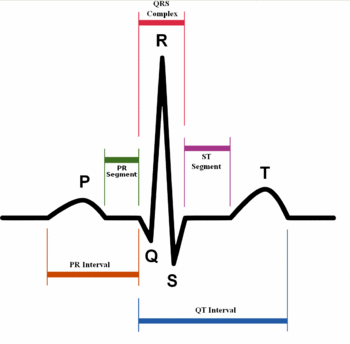QT interval
In cardiology and the electrocardiogram, the QT interval is the time from the start of the Q wave and the end of the T wave.[1]

To correct the QT interval for heart rate:
Normal values for the corrected QT interval are between 0.36 and 0.44 seconds.
A prolonged QT internal may lead to Torsades de pointes.
Acquired causes of prolonged QT interval
Hypokalemia and hypomagnesemia may extend the QT interval.[1]
Drugs may prolong the QT interval.[2] For example, 17 patients with Torsades de pointes were taking 65 mg to 1000 mg per day of methadone (mean daily dose of 397 mg) QTc ranges from 522 to 789 msec (average QTc 615 msec).[3]
A list of these drugs is available at the Arizona Center for Education & Research on Therapeutics.
Congenital Long QT Syndrome
Long QT Syndrome is a "condition that is characterized by episodes of fainting (syncope) and varying degree of ventricular arrhythmia as indicated by the prolonged QT interval. The inherited forms are caused by mutation of genes encoding cardiac ion channel proteins. The two major forms are Romano-Ward Syndrome and Jervell-Lange Nielsen Syndrome."[4]
Andersen Syndrome
Andersen Syndrome is a "form of inherited long QT syndrome (or LQT7) that is characterized by a triad of potassium-sensitive periodic paralysis, ventricular ectopic beats, and abnormal features such as short stature, low-set ears, and scoliosis. It results from mutations of KCNJ2 gene which encodes a channel protein (inward rectifier potassium channels) that regulates resting membrane potential."[5][6]
Jervell-Lange Nielsen Syndrome
Jervell-Lange Nielsen Syndrome is a "form of long QT syndrome that is associated with congenital deafness. It is characterized by abnormal cardioelectrophysiology involving the voltage-gated potassium channel. It results from mutation of KCNQ1 gene (Subtype 1 or JLN1) or the KCNE1 gene (Subtype 2 or JLN2).."[7][8][9]
Romano-Ward Syndrome
Romano-Ward Syndrome (LQT1) is a "form of long QT syndrome that is without congenital deafness. It is caused by mutation of the KCNQ1 gene which encodes a protein in the voltage-gated potassium channel."[10][11]
References
- ↑ 1.0 1.1 Al-Khatib SM, LaPointe NM, Kramer JM, Califf RM (2003). "What clinicians should know about the QT interval". JAMA 289 (16): 2120–7. DOI:10.1001/jama.289.16.2120. PMID 12709470. Research Blogging.
- ↑ Roden DM (March 2004). "Drug-induced prolongation of the QT interval". N. Engl. J. Med. 350 (10): 1013–22. DOI:10.1056/NEJMra032426. PMID 14999113. Research Blogging.
- ↑ Krantz MJ, Lewkowiez L, Hays H, Woodroffe MA, Robertson AD, Mehler PS (September 2002). "Torsade de pointes associated with very-high-dose methadone". Ann. Intern. Med. 137 (6): 501–4. PMID 12230351. [e]
- ↑ Anonymous (2024), Long QT Syndrome (English). Medical Subject Headings. U.S. National Library of Medicine.
- ↑ Anonymous (2024), Andersen Syndrome (English). Medical Subject Headings. U.S. National Library of Medicine.
- ↑ Online Mendelian Inheritance in Man, OMIM®. Johns Hopkins University, Baltimore, MD. MIM Number: 170390. World Wide Web URL: http://omim.org/.
- ↑ Anonymous (2024), Jervell-Lange Nielsen Syndrome (English). Medical Subject Headings. U.S. National Library of Medicine.
- ↑ Online Mendelian Inheritance in Man, OMIM®. Johns Hopkins University, Baltimore, MD. MIM Number: 220400. World Wide Web URL: http://omim.org/.
- ↑ Online Mendelian Inheritance in Man, OMIM®. Johns Hopkins University, Baltimore, MD. MIM Number: 612347. World Wide Web URL: http://omim.org/.
- ↑ Anonymous (2024), Romano-Ward Syndrome (English). Medical Subject Headings. U.S. National Library of Medicine.
- ↑ {{OMIM|192500}
External links
- Arizona Center for Education & Research on Therapeutics maintains a list of drugs that affect the QT interval.
